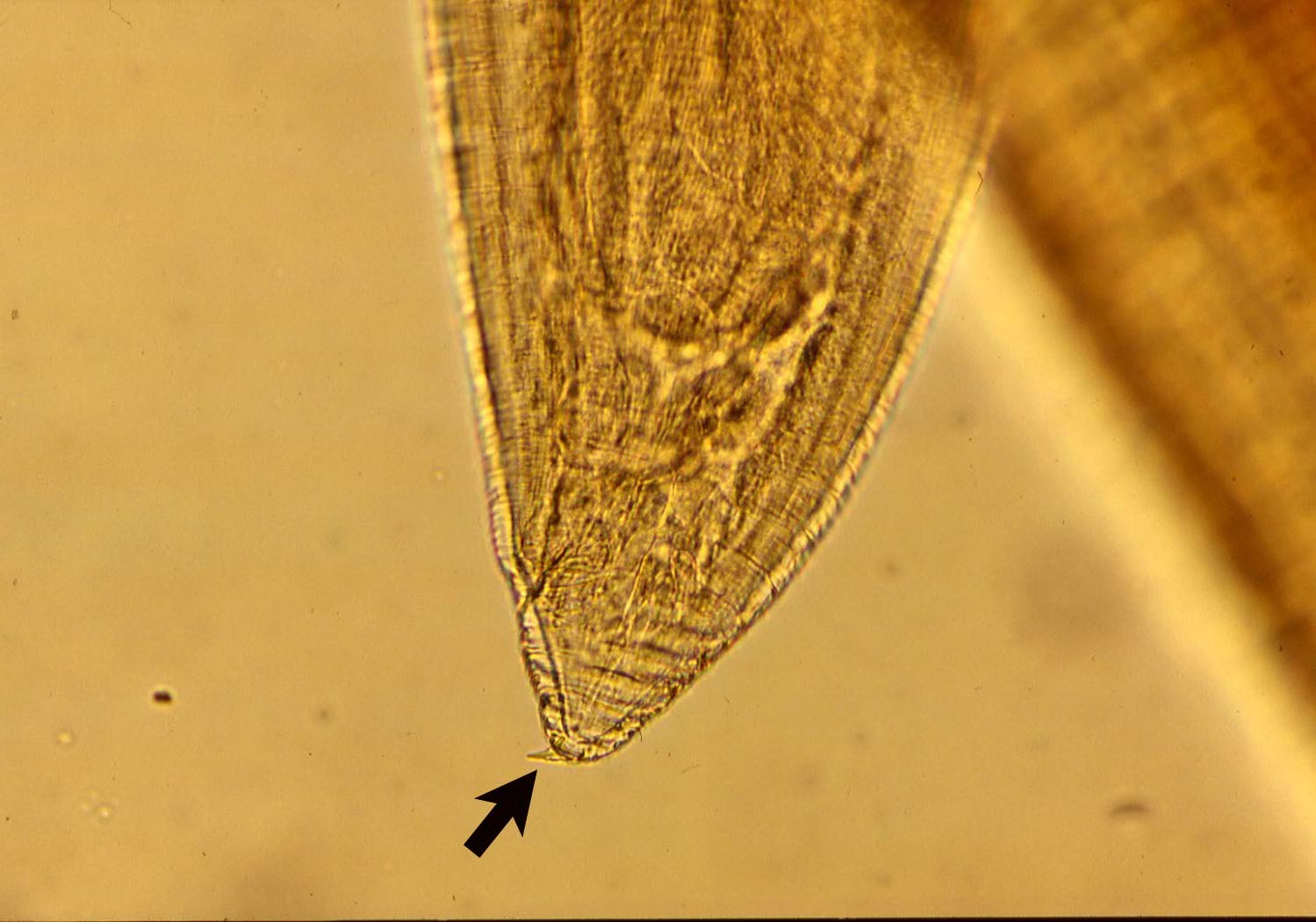
| Parasite | Pseudoterranova decipiens |
|---|---|
| Taxonomy | Nematoda, Secernentea, Anisakidae |
| Hosts | Japanese Spanish mackerel (Scomberomorus niphonius), chum salmon (Oncorhynchus keta), Pacific cod (Gadus macrocephalus), Alaska pollack (Theragra chalcogramma), Okhotsk atka mackerel (Pleurogrammus azonus), Japanese common squid (Todarodes pacificus), and many other marine fishes. |
| Infection site | Body cavity, visceral organs, muscle |
| Clinical sign | No external sign is observed. A filiform worm (1-4 cm in length) is found in the body cavity, liver and stomach wall. The worm is not coiled in the fish hosts. |
| Parasitology | Final host is mainly Pinnipeds (seal, sealion, etc.). Released larva hatched from an egg is ingested by crustacean, e. g. euphausiid. Fishes are infected by eating such krill. The parasite, red-brown in color, has the boring tooth at the anterior end (Fig. 1) and the mucro (tail spine) at the posterior end (Fig. 2). In a limited sense (sensu strict), ePseudoterranova decipiencef means only the one species P. decipience, meanwhile, in the broad sense (sensu lato), eP. decipiencef includes several species, which are genetically different each other (Paggi et al., 2000; Zhu et al., 2002). |
| Pathology | The effects of infection to the host are possibly low. |
| Health hazard | The live parasite, a causative agent of anisakiasis, penetrates into the wall of gut and causes the acute gastroenteritis, viz. violent abdominal pain, nausea and vomiting. Therefore, be careful when the host fishes is consumed raw. Heating or freezing to -20 C for 24 hours are effective for killing the parasite. |
| Diagnosis | Comparing to Anisakis, Pseudoterranova is larger and reddish in color. The distinct morphological characteristic is the presence of caecum in the latter species (Fig. 3). This parasite was diagnosed as Pseudoterranova decipience since the intestine is brownish yellow in color and the tail is conical and tapers from around the anus although the anterior part could not be observed. At present, several disgnostic methods such as PCR and restriction fragment length polymorphism (RFLP) mapping have been developediKijewska et al., 2002; Zhu et al., 2002; Nadler et al., 2005jB |
| Other information | Pseudoterranova decipience parasitizes mainly wild coldwater fishes and squids. Hence, Hokkaido is the most reported location of Anisakiasis caused by P. decipience (Ishikura, 1999). |
| References | Ishikura, H. (1999): Anisakiasis (2) Clinical pathology and epidemiology.
Progress of medical parasitology in Japan. Meguro Parasitological Museum, 7, pp.439-464 (in Japanese). Kijewska, A., J. Rokicki, J. Sitko and C. Wegrzyn (2002): Ascaridoidea: a simple DNA assay for identification of 11 species infecting marine and freshwater fish, mammals, and fish-eating birds. Exp. Parasiol., 101, 35-39. Nadler, S. A., S. DfAmelio, M. D. Dailey, L. Paggi, S. Siu and J. A. Sakanari (2005): Molecular phylogenetics and diagnosis of Anisakis, Pseudoterranova, and Contracaecum from Northern Pacific marine mammals. J. Parasitol., 91, 1413-1429. Paggi, L., S. Mattiucci, D. I. Gibson, B. Berland, G. Nascetti, R. Cianchi and L. Bullini (2000): Pseudoterranova decipiens species A and B (Nematoda, Ascaridoidae): nomenclatural designation, morphological diagnostic characters and genetic markers. Syst. Parasitol., 45, 185-197. Zhu, X. Q., S. Dfamelio, H. W. Palm, L. Paggi, M. George-Nascimento and R. B. Gasse (2002): SSCP-based identification of members within the Pseudoterramova decipiens complex (Nematoda: Ascaridoidea: Anisakidae) using genetic markers in the internal transcribed spacers of ribosomal DNA. Parasitology, 124, 615-623. |

Fig. 1. A boring tooth (arrow) at the anterior end of Pseudoterranova.
(Photos by K. Ogawa)


Fig. 3. A caecum (arrow) of Pseudoterranova.